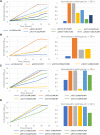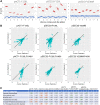Yeast Models of Phosphomannomutase 2 Deficiency, a Congenital Disorder of Glycosylation
- PMID: 30530630
- PMCID: PMC6385982
- DOI: 10.1534/g3.118.200934
Yeast Models of Phosphomannomutase 2 Deficiency, a Congenital Disorder of Glycosylation
Abstract
Phosphomannomutase 2 Deficiency (PMM2-CDG) is the most common monogenic congenital disorder of glycosylation (CDG) affecting at least 800 patients globally. PMM2 orthologs are present in model organisms, including the budding yeast Saccharomyces cerevisiae gene SEC53 Here we describe conserved genotype-phenotype relationships across yeast and human patients between five PMM2 loss-of-function missense mutations and their orthologous SEC53 mutations. These alleles range in severity from folding defective (hypomorph) to dimerization defective (severe hypomorph) to catalytic dead (null). We included the first and second most common missense mutations - R141H, F119L respectively- and the most common compound heterozygote genotype - PMM2R141H/F119L - observed in PMM2-CDG patients. Each mutation described is expressed in haploid as well as homozygous and heterozygous diploid yeast cells at varying protein expression levels as either SEC53 protein variants or PMM2 protein variants. We developed a 384-well-plate, growth-based assay for use in a screen of the 2,560-compound Microsource Spectrum library of approved drugs, experimental drugs, tool compounds and natural products. We identified three compounds that suppress growth defects of SEC53 variants, F126L and V238M, based on the biochemical defect of the allele, protein abundance or ploidy. The rare PMM2 E139K protein variant is fully functional in yeast cells, suggesting that its pathogenicity in humans is due to the underlying DNA mutation that results in skipping of exon 5 and a nonfunctional truncated protein. Together, these results demonstrate that yeast models can be used to characterize known and novel PMM2 patient alleles in quantitative growth and enzymatic activity assays, and used as patient avatars for PMM2-CDG drug screens yielding compounds that could be rapidly cross-validated in zebrafish, rodent and human organoid models.
Keywords: PMM2-CDG; Phosphomannomutase 2 Deficiency; congenital disorders of glycosylation; drug screens; yeast models of human disease.
Copyright © 2019 Lao et al.
Figures







References
Publication types
MeSH terms
Substances
Supplementary concepts
Associated data
LinkOut - more resources
Full Text Sources
Other Literature Sources
Molecular Biology Databases
